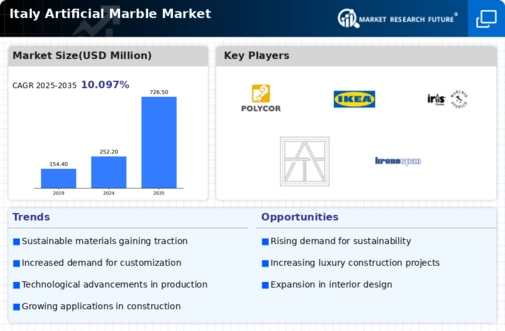Growth in Construction Activities
The artificial marble market in Italy is significantly influenced by the robust growth in construction activities across the country. With an increase in residential and commercial projects, the demand for durable and visually appealing materials has escalated. Recent statistics suggest that construction output in Italy has risen by 8% in the last year, leading to a corresponding increase in the consumption of artificial marble. This growth is fueled by the need for cost-effective alternatives to natural stone, which can be more expensive and less sustainable. As builders and architects increasingly specify artificial marble for countertops, flooring, and wall cladding, the artificial marble market is poised for continued expansion, driven by the ongoing construction boom.
Rising Demand for Aesthetic Appeal
The artificial marble market in Italy experiences a notable surge in demand driven by the increasing consumer preference for aesthetic appeal in interior design. As homeowners and commercial establishments seek visually striking materials, artificial marble emerges as a favored choice due to its versatility and ability to mimic natural stone. The market data indicates that the demand for artificial marble has grown by approximately 15% annually, reflecting a shift towards more visually appealing surfaces. This trend is particularly evident in urban areas where modern architecture and interior design trends prioritize elegance and sophistication. Consequently, the artificial marble market is likely to benefit from this growing inclination towards aesthetic enhancements, as consumers are willing to invest in high-quality materials that elevate the overall ambiance of their spaces.
Technological Innovations in Production
Technological advancements in the production processes of artificial marble are reshaping the market landscape in Italy. Innovations such as improved resin formulations and advanced manufacturing techniques enhance the quality and durability of artificial marble products. These developments not only increase the material's appeal but also reduce production costs, making it a more attractive option for consumers. The artificial marble market is witnessing a shift towards eco-friendly production methods, which align with the growing consumer demand for sustainable materials. As manufacturers adopt these technologies, the market is likely to see a rise in product offerings that cater to environmentally conscious consumers, potentially increasing market share by up to 20% in the coming years.
Increasing Renovation and Remodeling Activities
The artificial marble market in Italy is benefiting from a notable increase in renovation and remodeling activities among homeowners. As property owners seek to enhance the value and aesthetics of their residences, artificial marble surfaces are becoming a popular choice for kitchen and bathroom upgrades. Market analysis indicates that the home renovation sector has expanded by 12% recently, with artificial marble being a preferred material due to its affordability and design flexibility. This trend is particularly pronounced in urban areas where older properties are being modernized. The artificial marble market stands to gain from this renovation wave, as consumers increasingly opt for stylish yet cost-effective solutions to elevate their living spaces.
Shifts in Consumer Preferences Towards Sustainable Materials
The artificial marble market in Italy is experiencing a shift in consumer preferences towards sustainable materials, reflecting a broader trend in environmental consciousness. As consumers become more aware of the ecological impact of their choices, there is a growing demand for artificial marble products that are produced using eco-friendly processes. This shift is supported by market data indicating that approximately 30% of consumers prioritize sustainability when selecting materials for their homes. Consequently, manufacturers in the artificial marble market are adapting their offerings to include sustainable options, which may enhance their competitive edge. This trend suggests a potential for growth as environmentally friendly products gain traction among discerning consumers.
















Leave a Comment